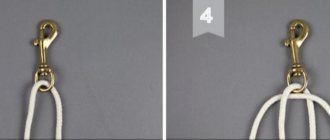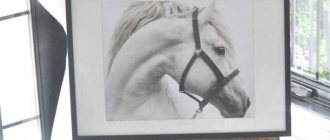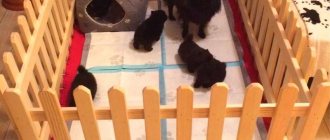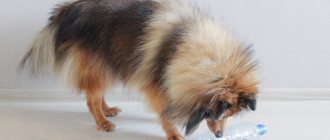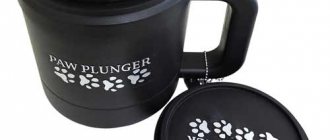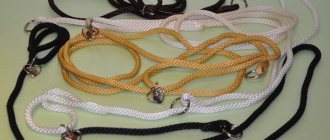Do-it-yourself outdoor for a private home
These are popular in dachas and large estates for large guard dogs. Keeping them chained is inhumane to the animal and irresponsible in terms of protecting your property. The chain was relevant when the local area was small. With the increase in the local area, this has lost its meaning: if at least some area is inaccessible to the dog, then the house is not protected.
In addition, a dog on a chain is an easy target for a serious thief, and losing a pet guard is not only sad, but also very expensive. After all, a well-trained guard dog is expensive. All this together is a compelling argument for making a house with your own hands, and letting the animal in there and letting it out at night.
Interesting: it has been proven that an animal living in an enclosure shows less aggression than one living on a chain. This is important if, in addition to the dog, there are children living in the house.
The following argument against building an enclosure often arises: the dog is friendly and roams freely around the area. Let's say the dog is really safe for everyone in the household, but what to do if your neighbors, guests, or utility workers come to the site? To avoid frantically starting to come up with ways to isolate a large animal, it is better to take care of this in advance.
Important : the outdoor enclosure must be a full-fledged home for the dog.
Indeed, guard dogs have been domesticated for a long time and today they need a cozy kennel and territory that they will protect. If you build an outdoor enclosure for a dog, following all the rules, spacious and cozy, it will not be perceived as a cage.
Collapsible aviary
Outdoor enclosures for dogs can be either prefabricated, dismountable, or stationary. The first ones are more universal; they can be moved or removed at any time as unnecessary, for example, if the enclosure was placed on a summer cottage and is not needed in winter.
These enclosures can also be called differently: permanent - a whole complex for keeping a dog, with a booth, a bed and a walking area; or simply a fenced area of territory - temporary .
Functions of an outdoor enclosure:
- restriction of free-range territory;
- ensuring the safety of the animal;
- protection from weather conditions (cold, rain, etc.);
- satisfying the dog’s desire to isolate itself from time to time, the need for its own territory.
Important : for an outdoor enclosure, it is important to have a walk - a spacious area in the fresh air, which will allow the pet not to sit locked up all day.
Aviary with walking area
Aviary layout:
Dimensions
Before you properly build a home enclosure with your own hands on the site, you must prepare a drawing so as not to make a mistake with the size and quantity of materials needed. The dimensions of the building are chosen based on standards developed by experienced dog breeders. You also need to take into account the breed of your pet.
The size of the enclosure will depend on:
- size of the animal;
- its breed;
- number of dogs in the building;
- the purpose of the enclosure - will the dog live there permanently, or walk around the territory.
The minimum area of a dog's house on the street is calculated based on the height of the animal at the withers:
- up to 50 cm – 6 sq. m;
- up to 60 cm – 8 sq. m;
- from 60 cm and above – from 10 sq. m.
Drawings with dimensions:
Other parameters are also calculated based on the animal’s body : the width must be at least one and a half body lengths (but without the tail). At the same time, you should not make the width less than 1.5 meters, even for small dogs. The length is calculated by area and width.
For the enclosure you need to calculate the height. To make this more difficult: you need to lift the dog by its front legs until it stretches to its full length. You will need an assistant to measure the distance from the front paws to the ground. Then you need to add another half meter to the resulting figure - this is the minimum height.
Important: there are especially jumping breeds of animals. For example, huskies are now fashionable: in their homeland, these dogs jump very high, this helps them navigate the endless white snow. To prevent the dog from jumping out of the enclosure, you will have to raise the walls higher.
All the above figures were given per animal. For two adult dogs, this area will need to be increased by one and a half times. The enclosure for a female dog with babies should be even larger, because the animals will actively explore the world.
You also need to pay attention to the breed : huge enclosures are perfect for large or active breeds - they will be able to warm up at any time. But bigger is not always better: a small dog in a large room will get lost in every sense. She will be scared and uncomfortable there.
Important : an outdoor enclosure is not suitable for permanent habitat of dwarf breeds; they do not overwinter in our climate.
The enclosure for breeds such as husky and alabai , which often appear in private homes, deserves special attention. What kind of enclosure should be for them?
Husky , as already mentioned, jumps well, so if you don’t want to catch it all over the area, raise the walls higher. This dog is also very active and sociable. In general, she is not suitable as a guard animal: she is too loving and gets bored easily. An enclosure for her can be set up only for the purpose of constant walking: the house will be a bit cramped for her. Even though the breed does not exceed 60 cm at the withers, it will need an area of 10 to 15 squares, with an aspect ratio of 2:3.
The size of the enclosure for the Alabai must correspond to this giant: in a small enclosure (as well as on a chain), the animal will quickly become embittered and become dangerous for the owner. This dog can also surprise with its jumping ability: an adult Alabai is able to jump over a height of about 3 m.
So before you build a do-it-yourself pen for your home, be sure to think it through carefully!
Materials
The main criteria here are safety for the owner and the animal . That is, the dog should not break free, nor should it be injured while trying to do this, or simply while living in an enclosure. If the building is stationary, one wall should be made blank, made of wood or even brick.
Often, in order to save money, the enclosure is attached directly to the wall of the house or to the fence:
Very stylish dog run
The remaining walls are made of lattice, from:
- Wooden or metal rods. Rods are the most reliable option, and this type of fencing is also easy to repair.
- Chain-link mesh. Chain-link mesh should only be used when there is not enough money for anything else: this cheap material can harm the dog. She can scratch herself on it, or break her teeth trying to gnaw through the mesh. But the chain-link is very easy to install.
- Forged. Forged enclosures are very beautiful, durable, but at the same time expensive.
- Made from galvanized pipes. A structure made of galvanized pipes will require considerable effort at the construction stage, but then it will last a long time.
Important : no matter what material you choose, you need to take care of its coating. The metal is coated with a special paint that prevents corrosion, and the wood is impregnated with a composition that will provide protection from rot and wood-boring beetles.
A winter outdoor enclosure must have a winter road! The winter road is a separate, carefully insulated room adjacent to an enclosure with a warm booth. We recommend that you build just such enclosures - they are the most profitable and convenient for your pet:
Building walls
How to do it yourself? The walls of the enclosure serve as a fence for a dog that wants to go outside. They bear the brunt of the load, so pay special attention to them. Before building walls, you need to take care of the foundation. There are several options here:
- The perimeter of the future structure is outlined, a trench is dug and a strip foundation is made.
- A columnar foundation is made only in those places where the supporting elements will be installed.
It is impossible to build walls without a foundation: the soil will subside over time, and the enclosure may become damaged.
Outdoor enclosures, as a rule, are built from metal or durable wood so that, in case of emergency, it can withstand the pressure of a large adult animal. In addition, an enclosure made of such materials will last a long time if it is used correctly.
A good option for an animal is a brick enclosure ; it will be warm and cozy, neither rain nor wind will get inside.
You can also make the enclosure out of wood: it’s easier, because you don’t have to do the masonry yourself. Often these options are combined: one brick wall and three made of metal lattice. Or a frame is welded from steel pipes and then sheathed in wood.
In practice, the best option is a welded rod fence . It is done according to this scheme:
- Make a frame.
- Make a lattice from cut rods, welding the fittings to a metal frame from a corner. The distance between the bars for large dogs is 10 cm, for others - approximately 5.
- Connect the frame to the support pillars using the same welding.
- Check whether all the elements are securely welded, or whether they are simply stuck: with a strong push, the animal will knock them out.
- Treat the structure against rust.
Important: a door must be built into the walls.
It should not be done in a blank wall: it is comfortable for the animal to see that someone is approaching it and will come in now. You should make sure that the door opens inward and not outward, otherwise your pet will easily knock it down. And in a fit of joy when greeting the owner, the dog can hit him with the door.
The door here is not made perfectly
Floor
So, let's build the floor! Gender is no less important. The trampled ground is definitely not suitable: some dogs like to dig around, and will quickly render the enclosure unusable. And the raccoon dog and a number of other breeds will dig their way to freedom without much effort.
The other extreme - a floor filled with concrete, “so as not to crawl out”, is also undesirable. These floors are cold, especially in winter, which will cause your dog to suffer and may get sick. A couple of years on a concrete floor and problems with paws are guaranteed .
It's best to stick with wood floors . They are warm and easy to install.
To make such a floor, you need:
- Prepare boards about 40 mm thick and rectangular beams.
- Treat the material with an antiseptic.
- Make a frame for the deck.
- Lay the boards on the frame, adjust the seams, then secure the flooring with self-tapping screws. The heads of the screws need to be recessed and puttied so that the dog does not get hurt.
- Paint the floor or varnish it.
Important : do not skimp on paint; a cheap and toxic product will damage a dog’s sense of smell, and without painting at all, the floor will quickly rot.
Making a roof
To build the roof, slate, tiles, corrugated sheets, siding or regular tarpaulin are used. The main thing is that the material does not resonate from wind and rain; this will damage the dog’s hearing, which is no less sensitive and subtle than the sense of smell. Soft tiles or fabric will solve this problem. Most often, the roof is made of the simplest, pitched roof.
Important: the roof must have a gap for ventilation, because heat and stuffiness are very harmful for the dog.
An excellent option is an awning . First you need to build a metal or wooden frame, and then stretch a fabric roof over it. The material must be waterproof. But the problem is that it’s difficult to sew such a tent yourself, and it’s not cheap to buy.
Chain-link enclosures with a tent roof. Not suitable for permanent housing
The simplest option is made of slate, siding or corrugated board. In this case, the frame is also built first. The roofing of the enclosure is laid on a reliable, well-sanded roofing system.
Feeder
The main stages of construction are behind us, the question remains of what the future inhabitant of the enclosure will eat from. There are several requirements for the feeder:
- raised above the ground to a height of 20-30 cm, that is, at the height of the lower edge of the dog’s chest, depending on its size. It is undesirable for these animals to eat from the floor, it is harmful to the back and paws;
- There are separate areas for food and water. Mixing must be avoided;
- the presence of a rotating mechanism in the feeder and the ability to fix it. This way, not only the owner, but also other people will be able to feed the dog safely in his absence.
The easiest way is to simply weld several bowls to the rods, but they will not spin. For the rotating device, a small rectangular frame is planned in advance in the frame, into which the rotating device of the feeder and drinker is inserted.
Scheme drawing:
How to make the toilet comfortable for the animal and the owner?
And finally, an important part of any enclosure is the toilet. It is advisable to immediately train the animal to relieve itself in one place, otherwise the number of general cleanings in the enclosure will increase from one annual, scheduled one to infinity. You can do it like this:
- Prepare a vessel suitable in size for the dog: from a bowl to a basin.
- Make a cutout in the floor for the toilet, placing it at a distance from the feeder and the booth.
- Temporarily cover the hole with board or plywood.
- Let the dog into the enclosure. For a while she can relieve herself anywhere.
- When the animal gets used to it, its waste is collected, but not thrown out. The dog needs to be taken out of the enclosure and cleaned up.
- After cleaning, the toilet is put back into place. The bowl is filled with sand and the pet's waste is placed on top.
- The dog is released into the enclosure. Now she will go to the toilet in the designated place, perceiving it as marked by herself. Sand is needed so that the animal can rummage; it will have to be changed periodically.
The method does not always work; sometimes the dog relieves itself everywhere. To make cleaning easier, the floor in the enclosure in this case is made with a slight slope towards one of the side walls or towards the facade. So it’s easy to wash off the sewage with a hose; with some skill you don’t even have to go inside.
What is an aviary
An aviary is a fenced area for keeping poultry, pets and dogs. It may or may not be covered.
One of the options for respectable pets
A dog enclosure is a building in which an animal can be kept. For large dogs, the enclosure is made outdoors, and in such a way that it can withstand the pressure of the animal for a long time.
This is an enclosure (fence) for small dogs
For small domestic dogs, an enclosure usually means a portable fence that allows you to limit their movement. The same enclosures are usually needed for older puppies, so that they do not wander around the house.
Photo
Elite enclosure designs: notice how beautiful they are!
We especially like the forged bars on the enclosures:
Modular:
With booth:
An original solution to build an enclosure made of bricks:
For a large dog, be sure to make a pen with a walk:
For two or three dogs:
Aviary for a medium breed dog (Akita Inu, Laika, Husky, etc.): drawings and dimensions
Medium breed dogs can be outside all day and all night. If it is not possible to keep your pet at home, it’s okay. For the dog’s convenience, it is enough to equip a spacious and comfortable enclosure. It must have a kennel that meets all the requirements and ideas about comfortable housing for dogs.
It is important to provide three zones in the enclosure: sleeping, eating and active pastime. In this case, the size of the booth should not exceed 65 centimeters in height and 80 cm in width
Only in this case will the four-legged friend inside be as comfortable as possible.
What should an enclosure be like for an average dog:
- pen area - from 6 to 10 square meters (less is not possible, the dog will be cramped inside, more is also not allowed - the dog will feel unsafe);
- the floor should be made of concrete and insulated with wooden boards. Only in this case can the enclosure be used in winter;
- three walls should be open, one should be closed. The last part of the building protects the four-legged friend from bad weather and wind;
- The height of the walls is from 2 to 2.5 meters, so that the dog cannot jump over them.
An adequate pen size is 3x3 or 2x4 meters. A sample drawing of the enclosure is presented below.
This is what a drawing of an enclosure for an average dog looks like. Length of the sides of the structure: 2 and 4 meters
The booth can be purchased at a specialized store or made independently.
Material selection and calculation
To make an enclosure for an average dog, you will need the following materials:
- bricks;
- welded mesh;
- metal pipes;
- cement;
- wooden boards;
- nails and screws;
- wood varnish;
- slate (metal tiles are also suitable);
- metal door frame with hinges;
- insulation material (expanded polystyrene, mineral wool, foam)
- pebbles, fine sand.
If you intend to create an enclosure with sides 4x2 meters and a wall height of 2.5 meters, you will need the following amount of material:
- 400 bricks (250 x 120 x 65 mm);
- 8 meters of welded mesh (mesh height - 2.5 meters);
- 3 twenty-five kilogram bags of dry cement;
- 4 metal pipes (each height is 3 meters, diameter is 20 centimeters);
- 1 can of varnish;
- 8 square meters of slate;
- 8 square meters of waterproofing material (roofing felt);
- 16 square meters of wooden board.
Required Tools
You don’t need any special tools when making an enclosure for an average dog. However, to attach the mesh to metal pipes, a welding machine is required. To carry out this work, it is likely that you will need the help of a professional.
Step-by-step instructions for making an aviary
So, let's start building the enclosure itself:
- Mark the area where the enclosure will be located and dig a trench around the perimeter. Fill it with stones and sand. This is the basis for the foundation.
- Place metal pipes in the corners. Each of them should rise 2.5 meters above the ground.
- Make formwork for the foundation and fill the trench with cement mortar.
- After 24 hours, the cement will dry and the floor can be poured. After the procedure, give it a day to dry. Be sure to make the floor with a slight slope.
- Cover the floor with insulation and wooden boards on top. Treat the floor with varnish for beauty and durability.
- Next, start laying out a blank brick wall. Its length is 4 meters. There are 16 bricks in one row. The height of the building is 2.5 meters. The bricks are connected to each other using cement mortar.
- Next, weld the mesh to the posts. On one of the small walls, install an iron frame for a human-sized door. The door itself is a metal frame with a welded mesh.
- Hang the door on hinges and provide a barn lock on the outside so that the dog cannot leave the enclosure without the owner’s knowledge.
- Start creating the roof. First, lay it out with wooden boards, lay roofing felt on top, then metal tiles. Such a roof will not leak and will withstand loads in the form of snow masses.
Design requirements and materials
Large breed dogs with good coats are not afraid of the cold. If they are outdoors all the time, they grow a thick undercoat, which perfectly protects them from the cold. It is much worse for them if they are either warm or cold. What’s also bad for them is a draft. Then a thick undercoat does not help. Therefore, one of the long walls of the enclosure must be sewn up; one or two of the short ones may be closed. With this device, in any direction of the wind you can find calm and the dog does not have to climb into the kennel.
Construction of housing for small dogs
The main rule to avoid miscalculations: measure a hundred times, cut once. From here, sketches and tips will give a correct and competent idea of the pet’s future home.
Construction requirements
- Dimensions are chosen no more than 6-8 m2. In a high and deep enclosure, the dog will become scared, uncomfortable and uncomfortable.
- The roof is partially covered or not done.
- The height of the walls is no higher than 1500 mm. There is no need to transfer money to the height of the room.
- A maximum of 2-3 walls are covered with solid material, 1-2 are open. The dog feels safe in such housing.
- The floors are covered with wood, poured with concrete with a panel covering. A small dog can easily catch a cold due to drafts, this must be taken into account.
- The loungers are made in the form of a children's mattress with a cross section of 12–15 cm.
The optimal dimensions of an enclosure for a dog with your own hands are inexpensive, according to the experience of dog handlers: 2×3; 3x3, 4x6 m. When constructing, it is useful to start working on drawings, mini projects, standard series, and, of course, recommendations from expert professionals.
Requirements for materials for construction
The construction of a dog enclosure is carried out in several stages. Each specific part of the structure is made separately from a specific type of material:
- the foundation is usually poured from a cement-sand mixture and reinforced with metal reinforcement;
- the floor is made of concrete or wood. It is necessary to make a flooring on top of the concrete, since the covering is bad for the joints and claws of dogs. In both cases, wooden boards are sanded, treated with antifungal substances, and varnished. The coating must be resistant to moisture and safe for the animal;
- Solid walls and partitions are made of wood. Suitable materials include lining, boards or sandwich panels. The wall for an open view in the walking area is made of chain-link mesh, profile pipes, metal pipes or forged elements. When choosing materials, you should pay attention not only to cost, but also to think about the safety of the dog. A mesh covering is cheaper than metal rods, but if a dog tries to chew through it, it can damage its teeth;
- It is better to make the roof from a soft, lightweight material that will not create loud noise and frighten the pet during precipitation.
Wall installation
DIY block staircase
It's time to talk about what to make the enclosure out of. The wall serves as an obstacle for the pet so that it cannot leave the territory without your desire, and also protects it from wind, bad weather and the scorching sun, and the dog also needs at least one lattice wall for contact with the environment and observation.
Nails should not be used to install walls, as an animal can tear them out; it is better to use self-tapping screws. In order to save money, you should not replace the grate with a mesh; not only can the dog break it, he can also get injured by it, as he will bite it.
For a large adult individual, a distance of 10 centimeters between the rods is suitable, for small ones - less. The main thing is that the dog's head cannot get stuck in the bars.
How to make it yourself
The most common options for do-it-yourself enclosures are made of metal and wood. We invite you to read simple instructions on how to make them.
It will be useful for you to learn how to care for a dog’s visual organs, how to properly care for a dog during a walk, how to motivate a dog with treats, at what age do puppies get their first vaccination, how to stop a dog from howling in the absence of its owners, what cereals can be used to cook a dog’s porridge, what included in the general dog training course.
Made from metal mesh
For this option you will need the following tools and materials:
- metal mesh (preferably not chain-link);
- metal rods (for small species you can also use wooden beams);
- wire (welding machine);
- pliers;
- door hinges.
The step-by-step process for making a metal enclosure is as follows:
- From rods we make a structure of the desired shape. The simplest and most common option is a parallelepiped.
- We stretch the mesh over the frame, leaving one wall free.
- In the corners, we connect the mesh with the rods with wire or weld it.
- We place the free wall on the door hinges.
- We attach the latch.
- The floor is covered with plywood and thick fabric.
Important! It is necessary to carefully check that there are no sharp parts, protruding remnants of wire, etc. in the enclosure, that is, anything that could injure the pet.
Made of wood
To build a wooden enclosure you will need:
- planks and slats made of wood;
- file;
- roulette;
- screwdriver;
- self-tapping screws;
- door hinges.
The process of installing a wooden fence consists of the following stages:
- We measure the required length of the slats and shorten them according to the size.
- We knock together a quadrangular frame from the planks using self-tapping screws.
- We measure the required height of the planks and nail them along the entire perimeter of the frame. The distance between the slats should be such that the animal’s head cannot fit through it.
- We make a frame for the doors from slats and stuff strips onto it.
- We put the doors on their hinges.
- We attach the latch.
The wood must be well processed to prevent splinters from getting into the dog's paws. Please note that wooden fences are not suitable for representatives of medium and large breeds.

